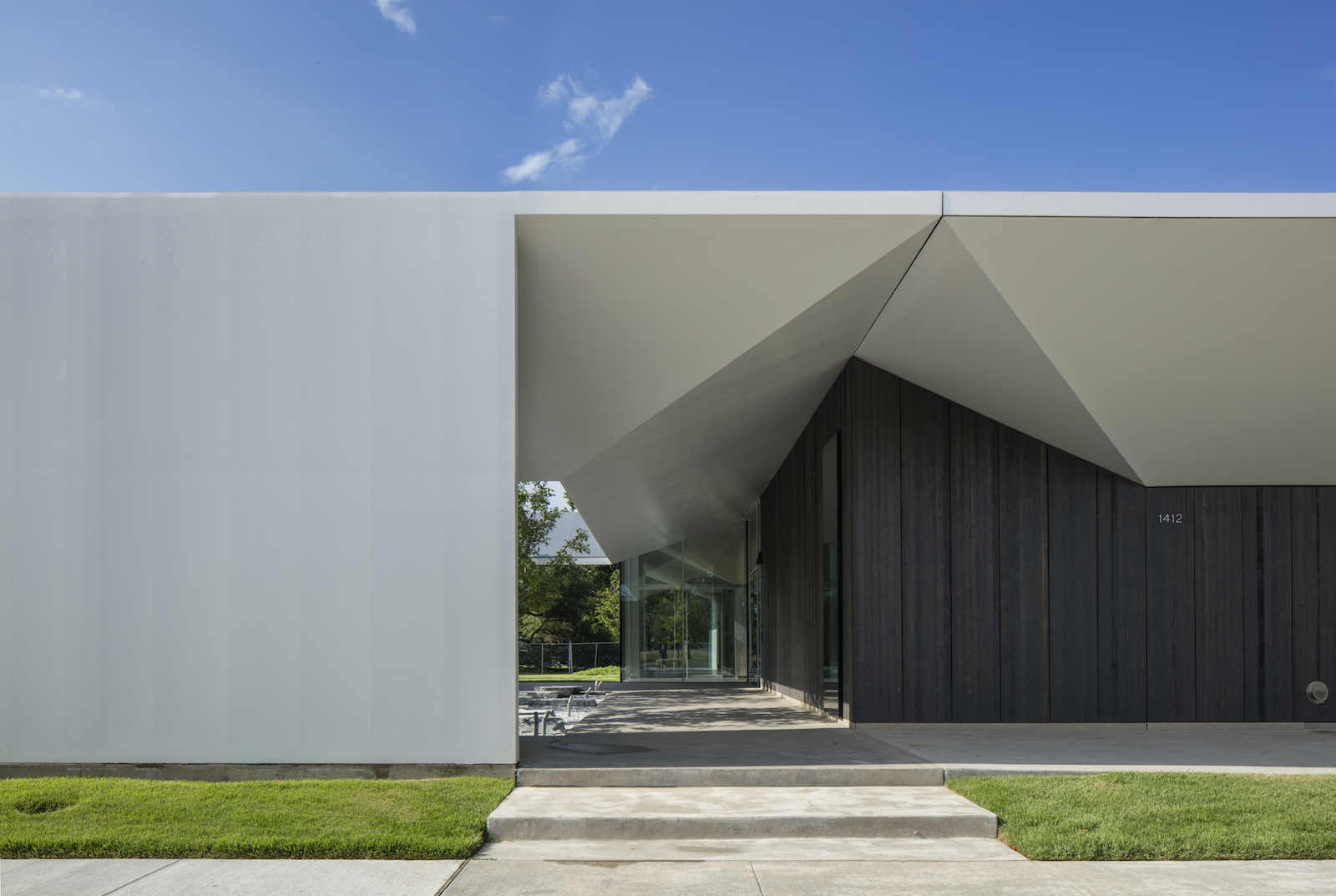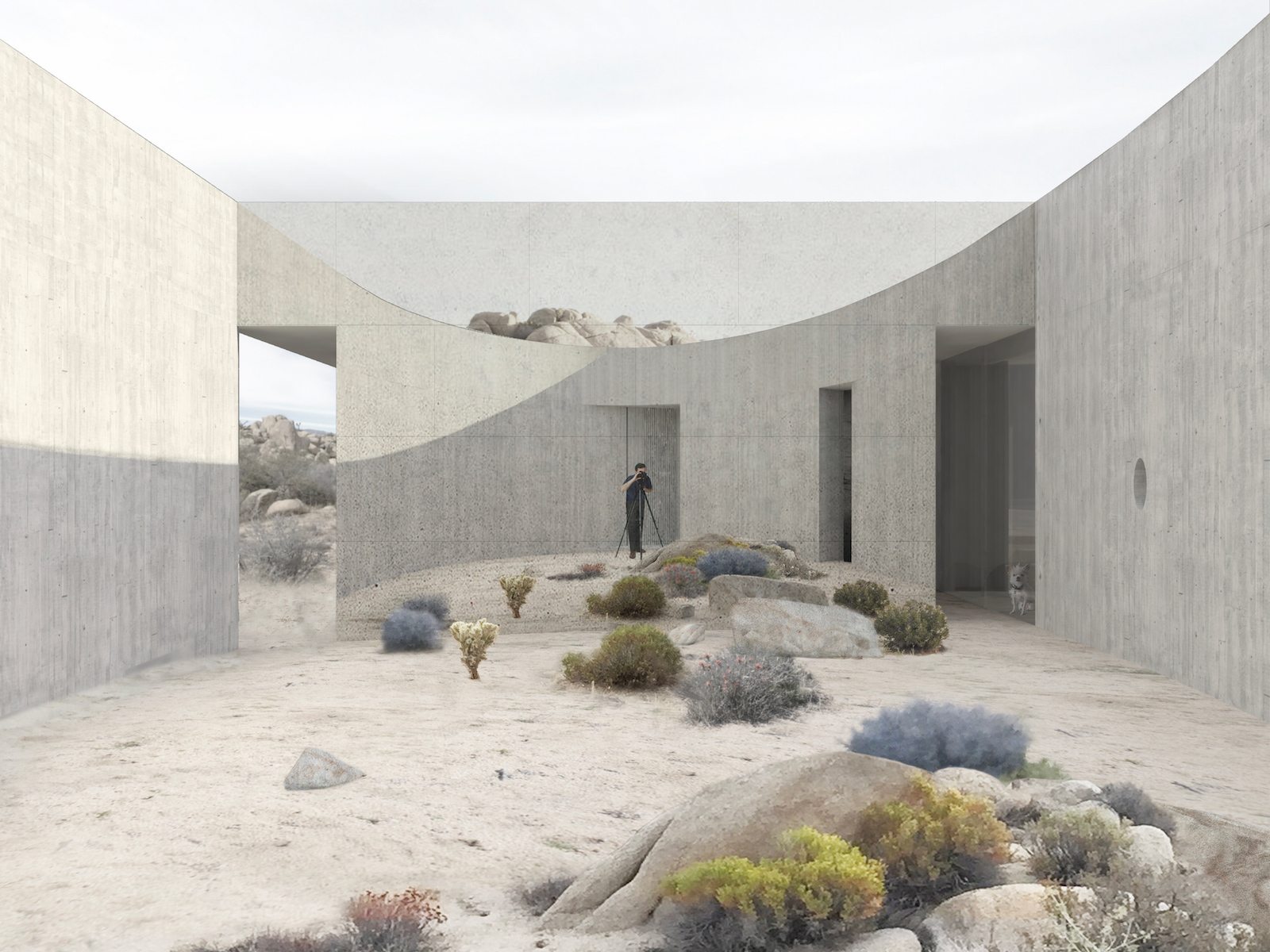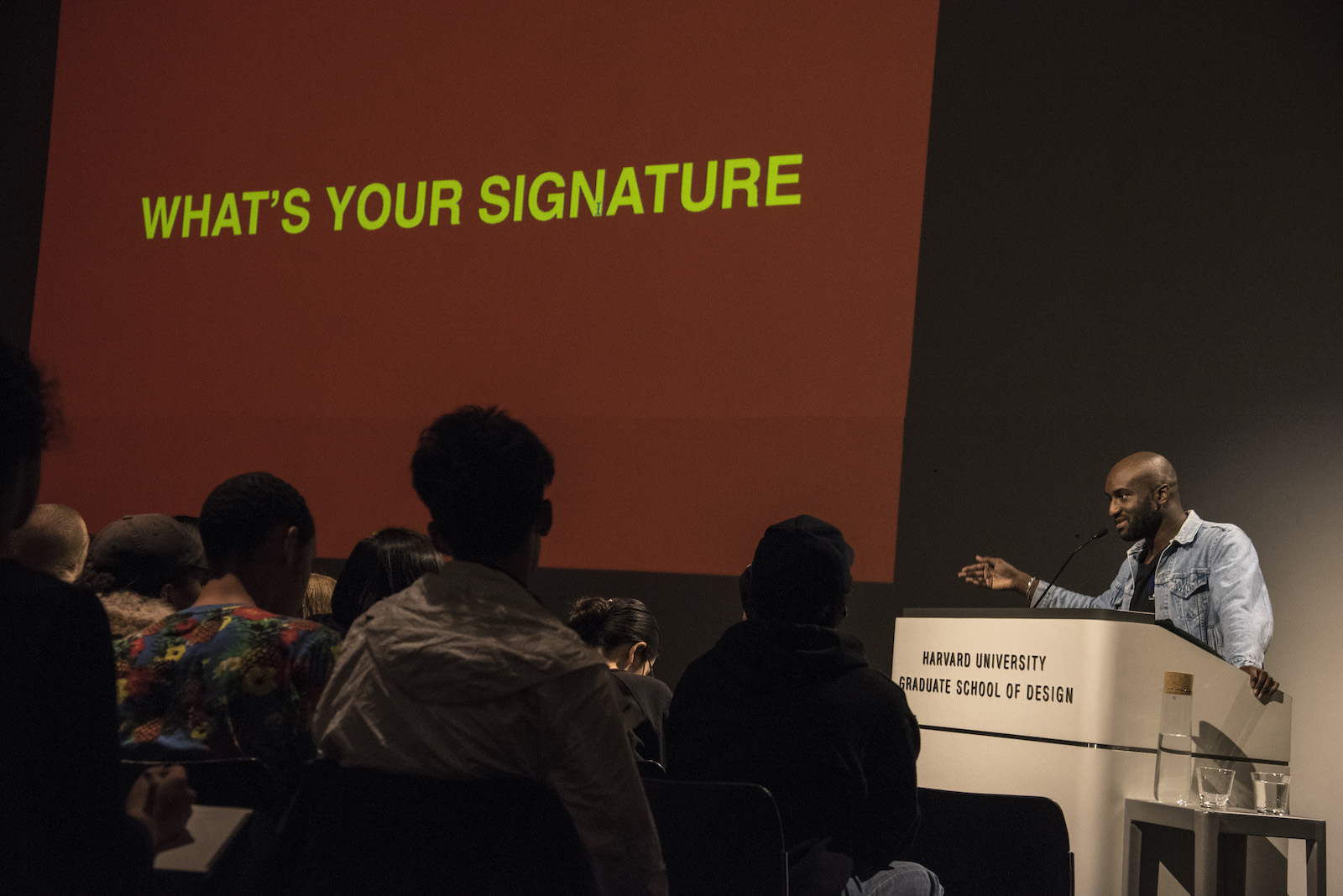Beate Hølmebakk discusses her paper projects and rejecting the dominance of user-friendly architecture

In 2004, Norwegian architect Beate Hølmebakk co-founded Manthey Kula with Per Tamsen, and the practice has since become known for small but beguiling architectural interventions that play with form and context in unexpected ways. From a heavy steel restroom overlooking Norway’s scenic Moskenes Island, to a transparent ferry port with a distinctive, U-shaped roof–both of which were nominated for the Mies van der Rohe European Union Prize for Contemporary Architecture–their work transforms humble briefs into arresting shapes uniquely suited to their site and purpose.
A significant part of Beate’s practice are her “paper projects”, works that are deeply considered but never intended to be built. In Virginia, a series of houses were conceived around the lives of four female literary characters; in Archipelago, the stories of five people living in isolation on remote islands were used to develop a set of architectural forms. Through these speculative explorations, Manthey Kula pushes the boundaries of architecture as a medium for exploring fictional states of mind, body and form.
Today, Holmebakk is a professor of form, theory and history at the Oslo School of Architecture and Design. Ahead of her lecture at Harvard’s Graduate School of Design, she discusses her philosophy and approach to both these types of projects, explaining how she measures the success of an idea and why architecture needs to “dare to have character”.
How do the two elements of your practice, the built and unbuilt works, relate to each other?
With the built work, we’re concerned with the site: how the building can make it more interesting, solve its problems or foreground its most beautiful elements. The unbuilt projects don’t have a site, so the internal story becomes the context. There’s always a narrative and an existential theme in the paper projects, which the architecture is built around. Whether a project is ultimately built or unbuilt, we’re interested in sculptural forms that have character. What ignites the form varies, but how we develop it is similar; it’s like the difference between prose and poetry.
Do you think of architecture as an artistic medium?
Absolutely. When we work as architects, we have a lot of measurable constraints and we’re trained to be logical in the way we develop a project, to show there’s a reason for our choices. But it’s the mix of personal, irrational elements that dictates if a project is going to be this or that. In the end, it’s about feeling trusted and believing in your own ideas.
At its best, I think architecture is a state of mind. There’s something about the experience of space that has been with us since we were small–a basic understanding that has to do with our personal story. I believe that’s an important factor in the way we work: the search for something eternal in our experience that we’re trying to recreate. When you enter a building or a space that is well made, it’s an existential experience.
Without rational parameters–for example with your paper works–how do you measure success?
In our paper works we create self-imposed constraints; it’s hard to develop anything without any limitations. In the beginning, it was more about trying to find a theme that could be dealt with architecturally, whether it was the relationship between people or between inside and outside. With the Virginia project, the architecture developed from personal interpretations of literary texts. Later on, for example with the Archipelago project, we imposed specific, almost mathematical constraints–for example, scales and measurements that were in use during the time when these historical protagonists lived.
You’ve said in the past that you don’t particularly like terms such as “user friendly” or “humane” as architectural aspirations. Why is that?
If you want a project that people can relate to, it has to have a core that people can agree or disagree with. It has to dare to have character. I think it would be a mistake to overlook the complexities that exist in our discipline and attempt to make architecture digestible for everyone. There are so many nuances in the world, so if one is only seeking a norm for what is “humane” or “user-friendly” in architecture, that would be incredibly boring.
Images courtesy Manthey Kula.
Work in Progress: Jiyun Jeong’s Arlington National Cemetery
Jiyun Jeong (MLA ’19) describes her final project for the option studio “Arlington National Cemetery: Engaging Hallowed Ground” led by Marty Poirier, fall 2018.
Work In Progress: Ting Liang and Zishen Wen’s Ephemeral City
Ting Liang (MAUD/MLA ’19) and Zishen Wen (MLA ’19) describe their final project for the option studio “Multiple Miamis” led by Chris Reed and Sean Canty, fall 2018.Work In Progress: Ian Miley’s future Provincetown
Ian Miley (MArch ’20) describes his final project for the option studio “The Future Provincetown 1” led by Preston Scott Cohen, fall 2018.
Taking up social and spatial equity in New York
Design and the Just City, an exhibition curated by the Harvard Graduate School of Design’s Toni L. Griffin and her Just City Lab at the GSD, arrives at the American Institute of Architects (AIA) Center for Architecture this month with fresh observations on social and spatial justice in New York. The exhibition debuted in the GSD’s Frances Loeb Library as part of the Spring 2018 exhibitions program. With a New York-focused twist, “Design and the Just City in NYC” is now on view at the AIA’s Center for Architecture through March 30, with a launch event on Thursday, January 10.
Like Griffin’s Just City Lab, Design and the Just City in NYC interrogates how design and planning contribute to the conditions of justice and injustice in cities, neighborhoods, and the public realm, and asks whether design can have an impact on correcting urban injustice, inequality, and disparity. Through ongoing research and dialogue, the Just City Lab has developed a series of tools for assessing and engaging with social and spatial justice issues, and these observations form the heart of Design and the Just City in NYC. Learn more about Design Labs at the GSD.
“There is growing interest among design and planning professionals and students to address issues of social and spatial injustice and disparity,” said Griffin. “Our team of student research assistants at the GSD are creating platforms for dialogue and profiles of practice that we hope prove the possibility of dismantling injustice.”
At the exhibition’s core is the Just City Index , a guide offering an itemization of 50 city- and community-building values and indicators—along them, acceptance, choice, democracy, mobility, and resilience—and a breakdown of the various definitions and approaches to fostering each value. Below, see photos from the exhibition’s GSD installation, and from the exhibition’s January 10 launch at the AIA Center for Architecture.
Design and the Just City in NYC also presents case studies and video conversations with a variety of voices, inviting visitors to contemplate the intention and effectiveness of design practice to address issues of social and spatial justice. In addition, an interactive map will invite visitors to determine what values they most associate with their neighborhoods, allowing them to plot collective manifestos for what might constitute a “just city.”
“Design and the Just City in NYC resonates with AIA New York’s 2019 presidential theme, BUILDING COMMUNITY, which asks members and professionals how they can contribute to communities inside and outside the profession. To this end, we are pleased to work with Professor Toni Griffin and her students from Harvard GSD, who have expanded their research to present a range of NYC projects,” said Benjamin Prosky, Assoc. AIA, Executive Director, AIA New York | Center for Architecture. “We are eager to share this work with our extended community as they continue to express interest in better understanding how design interventions can promote equity, especially at a time when cities have become places of extreme privilege and extreme poverty.”
For its Center for Architecture installation, the exhibition takes up five case studies in New York:
• D15 Diversity Plan, led by WXY, a community-based effort to make schools in Brooklyn’s District 15 more diverse and integrated
• Justice in Design, led by the Van Alen Institute, a plan to develop healthier and more rehabilitative jail infrastructure
• Center for Living and Learning, led by Perkins Eastman, which transformed an underutilized space into a community-driven, mixed-use space
• Under the Elevated, led by the Design Trust for Public Space, an initiative that reclaims spaces beneath high infrastructure for the public
• Public Life and Urban Justice in NYC Plazas, led by Gehl Studio, the J. Max Bond Center at Spitzer School of Architecture CCNY, and Transportation Alternatives, offering a study that evaluates effective public life and social justice in public space through a framework of metrics.
To learn more about Design and the Just City in NYC, visit the AIA’s website , and to learn more about Griffin’s Just City Lab, visit the lab’s website .
Harvard Center for Green Buildings and Cities unveils HouseZero
The Harvard Center for Green Buildings and Cities (CGBC) at the Harvard Graduate School of Design (GSD) announces today the completion of HouseZero, the retrofitting of its headquarters in a pre-1940s building in Cambridge into an ambitious living-laboratory and an energy-positive prototype for ultra-efficiency that will help us to understand buildings in new ways. The design of HouseZero has been driven by radically ambitious performance targets from the outset, including nearly zero energy for heating and cooling, zero electric lighting during the day, operating with 100 percent natural ventilation, and producing zero carbon emissions. The building is intended to produce more energy over its lifetime than was used to renovate it and throughout its subsequent operation. Snøhetta was the project’s lead architect and Skanska Teknikk Norway was the lead energy engineer.
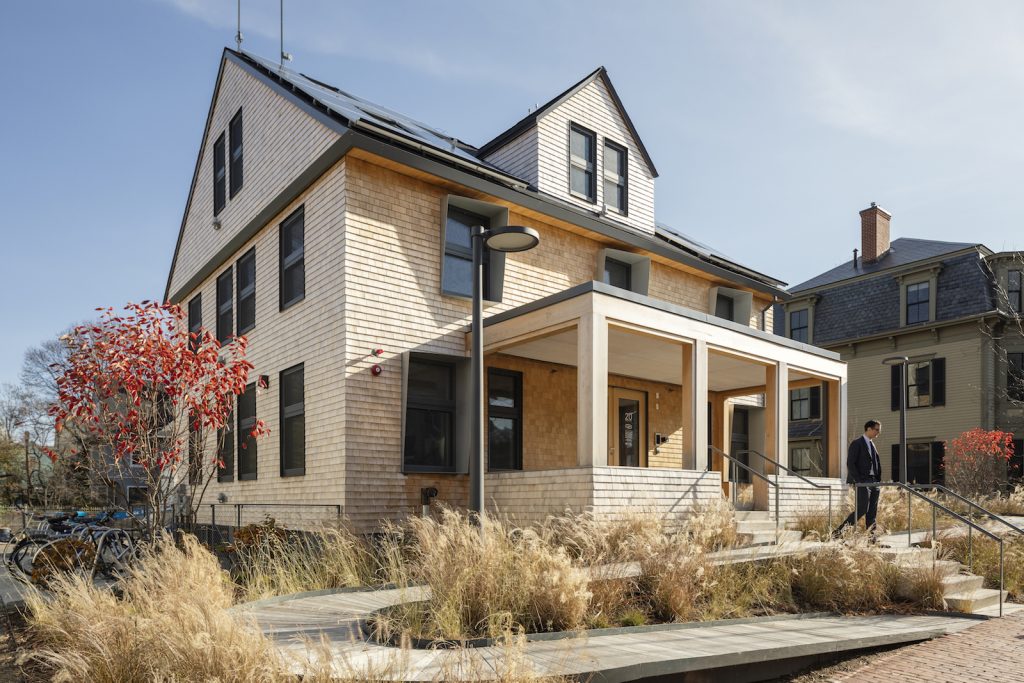
Leveraging HouseZero as both a workspace and a research tool, the CGBC will use millions of data points from hundreds of sensors embedded within each component of HouseZero to continually monitor its performance. This sensory data will also provide Harvard’s researchers with an unprecedented understanding of complex building behavior. This data will in turn, fuel research involving computational simulation, helping the CGBC develop new systems and data-driven learning algorithms that promote energy-efficiency, health, and sustainability.
“HouseZero’s flexible, data-driven infrastructure will allow us to further research that demystifies building behavior, and design the next generation of ultra-efficient structures,” said Ali Malkawi, founding director of the Harvard Center for Green Buildings and Cities and the creator and leader of the HouseZero project. “By creating both a prototype and an infrastructure for long-term research, we hope to raise interest in ultra-efficient retrofits and inspire substantial shifts in the design and operation of buildings.”
“Harvard HouseZero is an extraordinary physical example of efficiency and transformative design,” said Mohsen Mostafavi, Dean of Harvard GSD and the Alexander and Victoria Wiley Professor of Design. “As a living laboratory, it equips Harvard students and researchers with an unparalleled, innovative infrastructure for exploration and research as they design the next generation of sustainable buildings and cities around the world.”
As a prototype, HouseZero works to address one of the biggest energy problems in the world today—inefficient existing buildings. The U.S. building stock is responsible for around 40 percent of energy consumption, with housing nearly a quarter of that use. Property owners spend more than $230 billion annually heating, cooling and powering its 113.6 million homes. Addressing the energy-inefficiencies locked into this problematic building stock offers tremendous opportunity for curbing its impact on climate change. Paving the way through ultra-efficient retrofit strategies, HouseZero creates a blueprint for reducing energy demands and increasing cost savings for property owners.
“HouseZero demonstrates how to solve that problem by optimizing current technologies to achieve unprecedented building performance,” said Malkawi. “HouseZero challenged us to rethink the conventions of building design and operation to enhance lifelong efficiency and quality of life for occupants.” The ultra-efficiency of HouseZero lies at the intersection of cutting-edge technologies and applications of established, low-tech architectural design solutions. An example is natural ventilation, which is controlled by a window actuation system, which employs sophisticated software and sensors arrays to automatically open and close windows to maintain a quality internal environment throughout the year. The building itself will strive for best possible comfort; however a window can always be opened manually to ensure individual comfort still remains firmly tethered to human instinct.
HouseZero will be used to research how to fundamentally redefine how a structure can connect with and respond to its natural environment to promote efficiency and health. Rather than approaching the building as a “sealed box,” the building envelope and materials of HouseZero were designed to interact with the seasons and the exterior environment in a more natural way. The building will adjust itself constantly—sometimes by the minute— to reach thermal comfort for its occupants.
As a living lab, the Center’s researchers are afforded inspiring surroundings that they themselves will be able to control and adapt. With time, the CGBC’s research has the potential to greatly diminish the environmental impact of the building industry through widespread sharing and implementation of HouseZero’s findings and data-driven building research across new construction and future building renovations worldwide.
About the Harvard Center for Green Buildings & Cities
The Harvard Center for Green Buildings and Cities aims to transform the building industry through a commitment to design-centric and computationally-driven strategies that directly link research outcomes to the development of new processes, systems, and products. By strongly emphasizing innovation and multidisciplinary collaboration, the Center will work to promote holistic change within the built environment, namely the creation and continued improvement of sustainable, efficient, high performance buildings and cities. The CGBC was established at the Harvard Graduate School of Design in 2014.
Team Credits
Client: Harvard Center for Green Buildings and Cities
Lead Architect, Landscape Architect and Interior Designer: Snøhetta
Energy/Climate Engineer: Skanska Teknikk (Norway)
Structural Engineering: Silman Associates
MEP/FP Engineering, Lighting: BR+A
Civil Engineering: Bristol Engineering
BAS/Controls/Natural Ventilation System: WindowMaster
Acoustics: Brekke & Strand Akustikk
Code & Accessibility: Jensen Hughes
Geotechnical Engineering: Haley & Aldrich
Vertical Transportation: Syska Hennesy
Specficiations: Kalin Associates
BAS/Controls/Security Systems: Siemens Building Technologies
Photovoltaic System: Solect Energy
Landscape Architect, rear yard and surrounding properties: Reed Hilderbrand
Project Management: Harvard Planning & Project Management & CSL Consulting
Operations Support: Harvard Graduate School of Design Staff
Construction Manager: Columbia Construction
Sharon Johnston and Mark Lee debut Menil Drawing Institute, dedicated to modern and contemporary drawing, on November 3
On November 3, the Menil Collection will open its new Menil Drawing Institute building, designed by the Harvard Graduate School of Design’s Sharon Johnston and Mark Lee and their Los Angeles-based firm Johnston Marklee. Menil has also retained Michael Van Valkenburgh Associates as landscape architects to transform Menil’s outdoor experience.
Menil established the Menil Drawing Institute in 2008, dedicated to the study, conservation, and exhibition of modern and contemporary drawings. In 2012, following a year-long, international search, Menil named Johnston and Lee as architects for the Institute’s new building. The Menil Drawing Institute is the fifth and newest addition to the Menil Collection’s Houston campus; according to Menil, the building is the first freestanding facility built expressly for the exhibition, study, conservation, and storage of modern and contemporary drawings.

Johnston and Lee’s project totals 30,146 square feet and features a trio of spacious courtyards, as well as a design that modulates daylight to both illuminate and protect the Institute’s delicate artwork. Attention to landscape and gardening, in collaboration with Van Valkenburgh and team, was fundamental to the building’s design, Johnston notes; specifically, “trees are germane to the way light will work in the building,” she says.
In a video, Johnston and Lee discuss their design process and intention, citing the various influences that shaped their project as well as some of what they hope visitors gain from experiencing it.
Johnston speaks to the physical and conceptual juxtaposition of the public exhibition and the scholarly study of art, noting the proximity of the building’s gallery space to its more intimate spaces for scholarship, including a study center and a conservation lab. She notes, too, that despite a comparatively small physical footprint, the Institute represents a uniquely collaborative space with an expansive ethos.
Johnston and Lee also speak to the lineage of architects whose design DNA permeates the Menil campus—among them, Philip Johnson (who designed the de Menil family residence) and Renzo Piano (architect of the Menil Collection’s main center)—with Lee adding that, as he and Johnston responded to the design moves and intentions of their predecessors, he is excited to see how future campus architects might respond to the Drawing Institute.
Johnston and Lee also note the research into the de Menil family themselves—how they came to Texas, seminal buildings of theirs such as Rothko Chapel—and how this emphasis on lineage was fundamental to their design for the Drawing Institute. Among the other historical cues that informed Johnston and Lee’s Drawing Institute design are the gable roofs that characterize houses in the surrounding neighborhood.
At the GSD, Johnston and Lee are Professors in Practice of Architecture, and Lee is Chair of the Department of Architecture. They established Johnston Marklee in 1998 and have since been recognized nationally and internationally with over 30 major awards. A book on the work of the firm, entitled HOUSE IS A HOUSE IS A HOUSE IS A HOUSE IS A HOUSE, was published by Birkhauser in 2016. This followed a monograph on the firm’s work, published in 2014 by 2G.
Among other pedagogy, Johnston and Lee taught the Spring 2018 option studio “Museum Island,” which made a site on the Menil Foundation campus its focus of investigation, as well as the Fall 2015 option studio “The Architectural Double in the Museum City,” which resulted in a corresponding Studio Report.
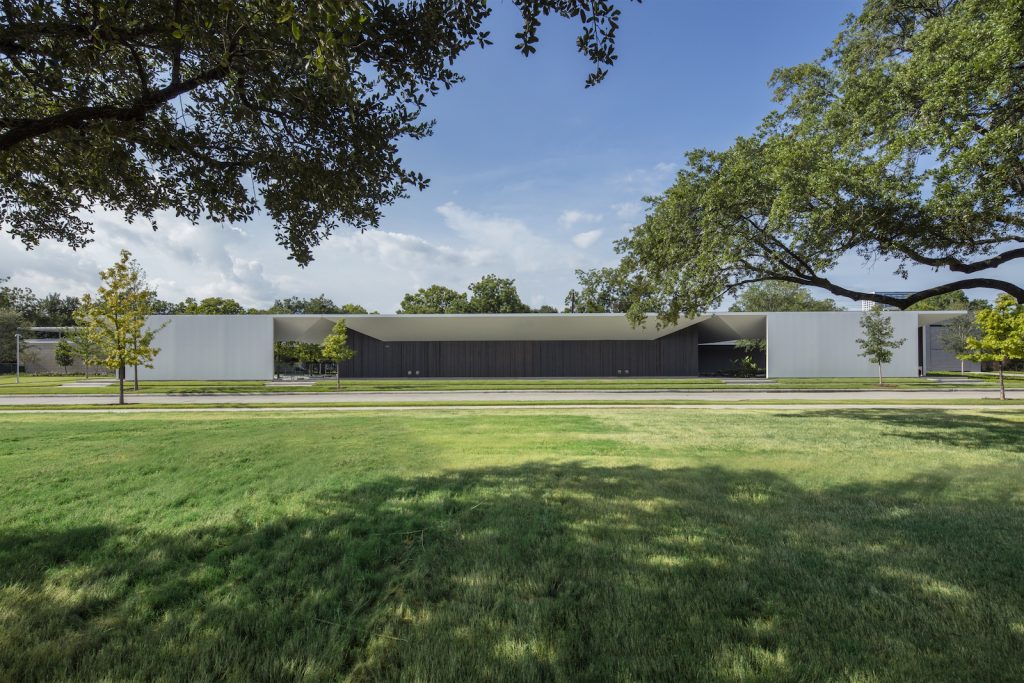
Hanif Kara on the research, engineering, and collaboration behind the Stirling Prize-winning Bloomberg headquarters in London
The Royal Institute of British Architects (RIBA) has awarded its 2018 Stirling Prize to Foster + Partners’ “monumental,” “once-in-a-generation” European headquarters for Bloomberg LP, a project engineered by the Harvard Graduate School of Design’s Hanif Kara and his firm AKTII. The Stirling Prize is RIBA’s most prestigious award, given annually to a new building in the United Kingdom deemed to have made the most significant contribution to British architecture in the past year.
In praising Bloomberg’s new London-based headquarters, RIBA observes that the “state-of-the-art” building “has pushed the boundaries of research and innovation in architecture,” themes central to practice and pedagogy for both Kara, who serves as Professor in Practice of Architectural Technology at the GSD, and Foster + Partners’ founding director Lord Norman Foster. The project was conceived in close dialogue with Michael Bloomberg, CEO of Bloomberg LP, and his New York-based team, all of whom collaborated with Foster + Partners regularly via workshops and other idea-sharing platforms.
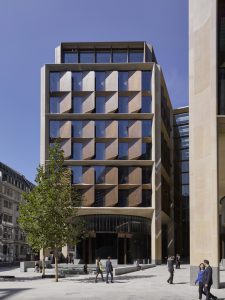
The 2018 Stirling Prize judges were unanimous in their choice of Bloomberg as this year’s prize-winner. RIBA president Ben Derbyshire praises the project as a “monumental achievement.” The 2018 jury, chaired by Sir David Adjaye OBE, said, “The design process involved unprecedented levels of research, innovation and experimentation, with pioneering new details and techniques tested, prototyped – sometimes at 1:1 scale – and rigorously improved.”
Foster + Partners served as architect for the project, with AKTII as civil and structural engineer and Kara as design director, overseeing a team that averaged 25 engineers at the director and associate levels, as well as researchers, computer scientists, and others.
Bloomberg marks the third time since 2000 that AKTII has been honored with the Stirling Prize, with previous triumphs in 2012 (Sainsbury Laboratory) and 2000 (Peckham Library). The firm has been short-listed for the prize seven times in that time.
Thought to be the largest stone building in the City of London since St. Paul’s Cathedral, the Bloomberg project’s 1.1 million square feet occupy an entire city block and offer work space for an estimated 4,000 staff. The physical project comprises two buildings joined by a bridge, with a public arcade beneath.
Kara and his AKTII colleagues have been researching and engaging with the Bloomberg site, in London’s The City district, since 2004. Bloomberg LP purchased the site in the late 2000s and asked AKTII to support a limited design competition, from which Foster + Partners was selected. Foster + Partners and AKTII were appointed to deliver the project from conception through to construction, enriching it with a conceptual and architectural continuity that Kara says lies at the heart of his GSD pedagogy.
“The ‘thought-to-construction’ element gives architects the opportunity to allow the research on and nature of the project to balance out and inform the selection of experts and other collaborators, rather than it being predetermined,” Kara observes. “This is a question I have dealt with in my GSD courses, especially in ‘Interdisciplinary Design in Practice’: how design research manifests itself beyond academia, and the advocacy that architects must apply in order to understand the project not just as a building, but to draw on what they want built.”
Reflecting on the process and triumph of the Bloomberg project, Kara notes a variety of technical innovations that position the headquarters as an exemplar of the “work space of the future,” one that promotes personal well-being for inhabitants, environmental sustainability (RIBA writes that the building has been credited as the most sustainable office in the world), and employee productivity and idea-sharing.
“These are topics we all deal with at school in our teaching and in debates that we have about the challenges the next generations face, and how great design can steward that,” Kara says. “The optimistic arc the project sets is a direct message to our students and alumni.”
Unlike many office buildings, services like elevators and staircases are pushed to the building’s edges so workspaces for meeting and collaborating form the core of the building. All entrants pass through the building’s main lobby before being drawn into what’s been called “the Vortex,” a dramatic, double-height space framed by three large, curved timber shells. From there, visitors can take high-speed elevators directly to the sixth-floor “Pantry,” where a concourse and café offer views across the city.
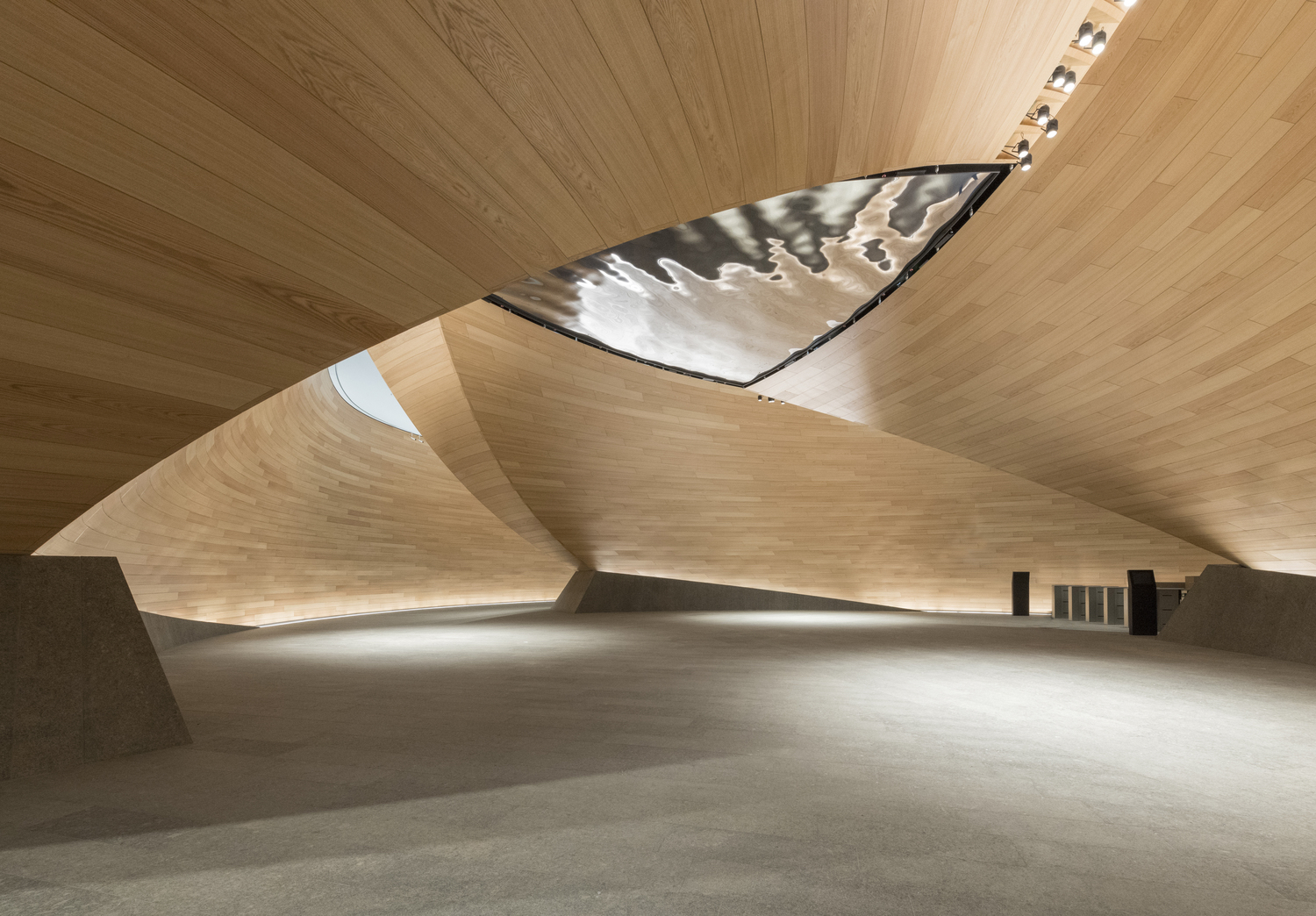
Among the various site-specific challenges that Kara and colleagues faced, researchers uncovered findings like an active Victorian Era sewer and roughly 6,000 existing piles accumulated from the site’s use over the past century, rendering it almost undevelopable. Elsewhere, traces of the ancient Romans both complicated and enriched the project. In sum, the team discovered over 14,000 Roman artifacts on site. Deep within, the legendary Temple of Mithras has been returned to its former location, supplemented by a new interactive museum. And, in its finished form, the building brings to light a once-forgotten Roman road, reincarnated as a pedestrian route.
In delivering the project to construction, Kara speaks of the challenge of wrangling with these site conditions, while also sourcing the best technologies and craftwork—especially for the building’s impressive, 10-story stone facade, which Kara notes is a primary structure (albeit separated from the floor-support structure), rather than a curtain wall.
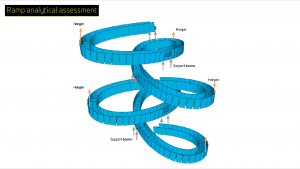
Elsewhere in the project are similarly ambitious innovations that exemplify design research translated into sensory experience. Inside, a 210-meter high, triple-helix, bronze ramp leads upstairs, with a width that allows for spontaneous gatherings and conversations without impeding foot traffic. A water sculpture entitled “Broken Rivers,” by artist Cristina Iglesias, sits at the public level. The timber-shell “Vortex” space includes a rippling, mirrored piece by artist Olafur Eliasson.
Throughout, systems for power, lighting, water, and ventilation make reuse of waste and respond to the building’s external climate as well as its internal occupancy patterns. The building’s multi-function ceilings are fitted with 2.5 million polished aluminum “petals” that work to regulate temperature, light, and sound.
Conceiving and creating each of these features necessitated close collaboration among client, architects, and specialized craftspeople. As client, Bloomberg LP expressed in the project brief a desire for the design team to continually question norms, creating conditions for “intense and vigorous” dialogue, Kara observes. “The positive fallout is that the architect was then both empowered and given responsibility,” he says.
“It is difficult to separate architecture from engineering, and design from construction, with this project,” Kara observes. “That is its greatest achievement.”
Jon Lott, Andrew Holder, and Eric Höweler among winners of Architect magazine’s 65th annual Progressive Architecture Awards
Among the 10 projects Architect magazine has honored with its 65th annual Progressive Architecture Awards are three by Harvard Graduate School of Design faculty. The three GSD honorees are assistant professor of architecture/MArch I Program Director Jon Lott (MArch ’05) for “Pioneertown House”; associate professor of architecture Eric Höweler for “Float Lab”; and assistant professor of architecture Andrew Holder for “Restaurant in Los Angeles.”
“There is a thrilling moment in every creative endeavor, when an idea has been wholly fleshed out and developed, but not yet realized in physical form. That particular moment of anticipation, of innovation on the cusp, is what the Progressive Architecture Awards celebrate,” Architect magazine says. “For 65 years and counting, the P/A Awards has served as a crystal ball for the built environment, revealing the influences, typologies, forms, and techniques of tomorrow.”
Lott designed the winning “Pioneertown House ” through his firm PARA Project, intended for a site in the “seemingly alien landscape” of the Mohave Desert, in California’s Pioneertown. The particular site is a 5-acre boulder parcel owned by a Los Angeles couple seeking a weekend getaway and artist studio.
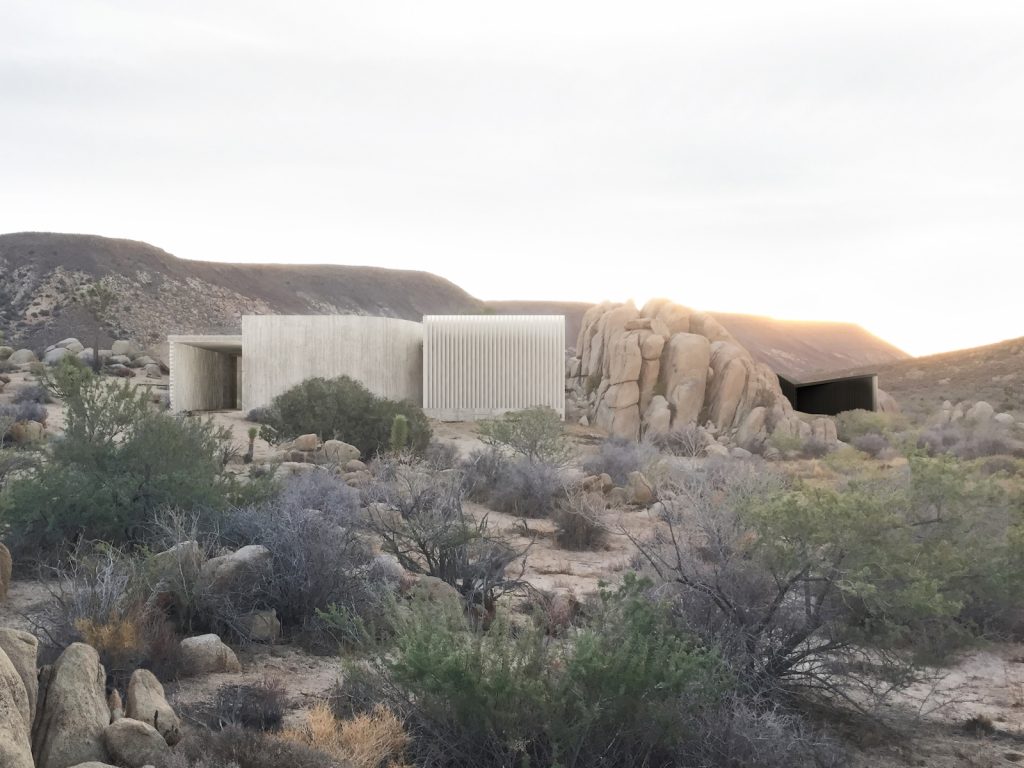
Lott took the existing cabin, built in the 1950s, and designed “a house around this house.” As the firm’s project description reads, “[Pioneertown House’s] organization takes cues from the natural landscape. But rather than piles of boulders (objects) it experiments with piles of rooms (voids). It plays with a ‘pilgrimage’ for these domestic types: rooms, courts, closets, counters, bookcases, pantries… All are actors. All pile and gather around the homestead.
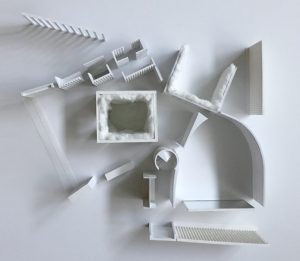
“The separation and movement between them makes common ground between interior and landscape,” the firm continues. “Each of the rooms relates to the natural in very particular ways.”
Awards juror Florian Idenburg, associate professor in practice of architecture, noted the project “is formally very interesting: a collage of almost found spaces assembled into a whole. There is also something really elegant about how the interior and exterior blend together.”
Höweler takes a pier along Philadelphia’s Schuylkill River as the site for Höweler + Yoon Architecture’s “Float Lab ,” which garnered an honorable mention in this year’s awards. Höweler designed the project alongside Höweler + Yoon’s J. Meejin Yoon (MAUD ’97).
“Float Lab” comprises a downward-sloping path from the pier’s furthest end, eventually semi-submerging pedestrians under the water level; the river water is held back by a steel wall lining the walkway, and floatation is achieved by a ballast that maintains the structure at the water’s surface.
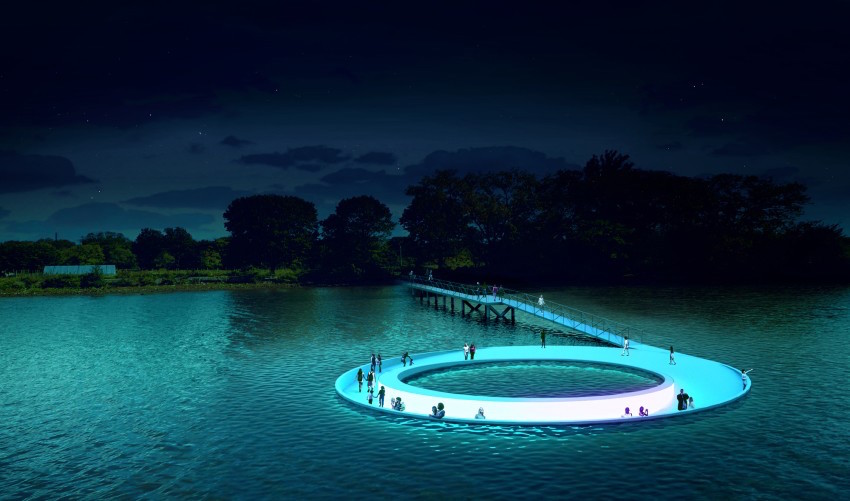
As visitors proceed, they hear sounds of the river’s current and splashes via speakers inside the promenade.
“Using the site of a polluted urban river system which continues to undergo clean-up efforts from coal mining and other industrial manufacturing by-products, ‘Float Lab’ proposes to create an environmental installation, to re-experience the river in a completely new way,” reads the firm’s project description. “The resulting design allows the public to experience a significant urban American waterway and its ecology in a manner that ties environmental science to environmental art, and allows us to learn about how perception can influence stewardship.”
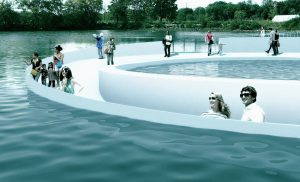
“I think it’s very topical, and I think it’s interesting how it addresses the issue of rising tides,” noted juror Reto Geiser. “I imagine being there with your head just above the water is a powerful experience.”
Also receiving an honorable mention, Holder’s “Restaurant in Los Angeles ” presents a freestanding, two-story, indoor/outdoor restaurant in Venice Beach, California. The project arose from an unusual commission: design on spec, for a developer seeking to fill the space with a concept restaurant.

“Restaurant in Los Angeles” aims to create a sense of space and interior without a permanent envelope. To do so, Holder and LADG employed a sequence of intersecting barrel vaults to create a spatial experience of “niches and episodes,” heightened by construction technique and materiality.

With an eye to sustainability, the building is designed to take advantage of its own thermal mass: concrete and masonry systems hold down the maximum daytime temperature while re-radiating heat as the air temperature cools at night. This and other passive systems are augmented by a hydronic heating and cooling system embedded in the concrete that will raise or lower the temperature of the mass a few degrees during the day.
Read more about each of these projects, as well as the seven other awardees, in Architect magazine’s full feature .
Ideas (and sneakers) in the air for Virgil Abloh
As the Harvard Gazette notes, “It was probably the first time a Harvard lecture ended with audience members tossing their sneakers toward the podium.”
Such was how Virgil Abloh’s October 26 talk at the Harvard Graduate School of Design reached its conclusion. Entitled “Insert Complicated Title Here,” Abloh’s talk encouraged the packed Piper Auditorium crowd (some attendees traveled from as far away as Syracuse, New York, to attend the talk) to find their creative voices and directions. Founder of the Milan-based fashion label Off-White, and collaborator with the likes of Ikea, Nike, and Kanye West, Abloh also passed around different prototypes of sneakers he has in the works, and shared photographs of concepts for a forthcoming furniture collection.
Abloh, who holds a Master in Architecture from Illinois Institute of Technology, noted he’s been inspired by the work of Rem Koolhaas, Donald Judd, and Jim Joe, among others. View Abloh’s full GSD lecture via the GSD’s YouTube channel .
“He’s a contemporary young voice who can disrupt. Architecture needs some disruption,” Eric Höweler, associate professor of architecture, told the Gazette. “Design has never been as well-regarded as it is today. He’s connecting to people, to clients, to fashion. It’s great for people to think big about design, not just architecture.”
Toward the lecture’s end, Abloh asked for the return for a sneaker prototype that he had shared with the audience. In return, he offered to autograph the first few sneakers that made their way to the podium. Ultimately, he autographed more than a few.
Read the Gazette’s full review via its website .



